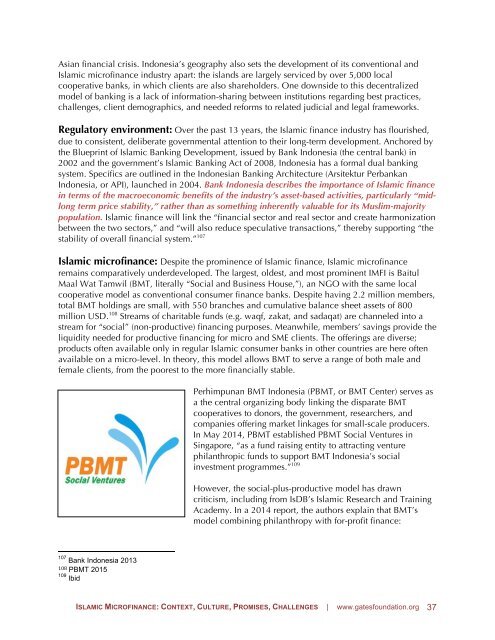ISLAMIC (MICRO)FINANCE
TrYIw
TrYIw
Create successful ePaper yourself
Turn your PDF publications into a flip-book with our unique Google optimized e-Paper software.
Asian financial crisis. Indonesia’s geography also sets the development of its conventional and<br />
Islamic microfinance industry apart: the islands are largely serviced by over 5,000 local<br />
cooperative banks, in which clients are also shareholders. One downside to this decentralized<br />
model of banking is a lack of information-sharing between institutions regarding best practices,<br />
challenges, client demographics, and needed reforms to related judicial and legal frameworks.<br />
Regulatory environment: Over the past 13 years, the Islamic finance industry has flourished,<br />
due to consistent, deliberate governmental attention to their long-term development. Anchored by<br />
the Blueprint of Islamic Banking Development, issued by Bank Indonesia (the central bank) in<br />
2002 and the government’s Islamic Banking Act of 2008, Indonesia has a formal dual banking<br />
system. Specifics are outlined in the Indonesian Banking Architecture (Arsitektur Perbankan<br />
Indonesia, or API), launched in 2004. Bank Indonesia describes the importance of Islamic finance<br />
in terms of the macroeconomic benefits of the industry’s asset-based activities, particularly “midlong<br />
term price stability,” rather than as something inherently valuable for its Muslim-majority<br />
population. Islamic finance will link the “financial sector and real sector and create harmonization<br />
between the two sectors,” and “will also reduce speculative transactions,” thereby supporting “the<br />
stability of overall financial system.” 107<br />
Islamic microfinance: Despite the prominence of Islamic finance, Islamic microfinance<br />
remains comparatively underdeveloped. The largest, oldest, and most prominent IMFI is Baitul<br />
Maal Wat Tamwil (BMT, literally “Social and Business House,”), an NGO with the same local<br />
cooperative model as conventional consumer finance banks. Despite having 2.2 million members,<br />
total BMT holdings are small, with 550 branches and cumulative balance sheet assets of 800<br />
million USD. 108 Streams of charitable funds (e.g. waqf, zakat, and sadaqat) are channeled into a<br />
stream for “social” (non-productive) financing purposes. Meanwhile, members’ savings provide the<br />
liquidity needed for productive financing for micro and SME clients. The offerings are diverse;<br />
products often available only in regular Islamic consumer banks in other countries are here often<br />
available on a micro-level. In theory, this model allows BMT to serve a range of both male and<br />
female clients, from the poorest to the more financially stable.<br />
Perhimpunan BMT Indonesia (PBMT, or BMT Center) serves as<br />
a the central organizing body linking the disparate BMT<br />
cooperatives to donors, the government, researchers, and<br />
companies offering market linkages for small-scale producers.<br />
In May 2014, PBMT established PBMT Social Ventures in<br />
Singapore, “as a fund raising entity to attracting venture<br />
philanthropic funds to support BMT Indonesia’s social<br />
investment programmes.” 109<br />
However, the social-plus-productive model has drawn<br />
criticism, including from IsDB’s Islamic Research and Training<br />
Academy. In a 2014 report, the authors explain that BMT’s<br />
model combining philanthropy with for-profit finance:<br />
107 Bank Indonesia 2013<br />
108 PBMT 2015 <br />
109 Ibid <br />
<strong>ISLAMIC</strong> <strong>MICRO</strong><strong>FINANCE</strong>: CONTEXT, CULTURE, PROMISES, CHALLENGES | www.gatesfoundation.org 37


